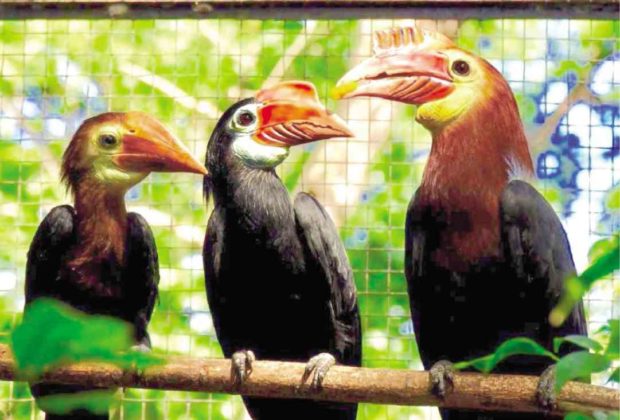Negros zoo succeeds in breeding critically endangered hornbill

HELLO, FEATHERED FAMILY Walden’s hornbill chick Valentin (left), here preening with parents Ligaya and Kalantiaw, has been celebrated by zoo keepers at the Negros Forest Park in Bacolod City since emerging from a hole in a tree trunk with his mother on April 19. —DINO GUTIERREZ/CONTRIBUTOR
BACOLOD CITY, Negros Occidental, Philippines — For 105 days, Jimmy Benzuela didn’t take a day off as head keeper of Negros Forest Park here.
He wanted to make sure the mother Walden’s hornbill named Ligaya and her chick were taken care of while holed up inside a tree trunk in this conservation center located along Capitol Road.
“Being one of the zoo keepers, I have much joy and pride, that for the first time I was able to successfully hatch a rufous-headed hornbill,” he said.
When both mother and chick finally emerged on April 19 after 105 days, everyone in the center was overjoyed.
First in nine years
“It took us nine years to have our first ever successful breeding. They take so long to mature, and bonded pairs are hard to form in captivity. Pairs have to be totally compatible to breed successfully,” said Fernando Gutierrez, president of Talarak Foundation Inc. (TFI).
TFI manages Negros Forest Park, formerly known as Negros Forest and Ecological Foundation Inc. Biodiversity Conservation Center.
The Walden’s hornbill (Rhabdotorrhinus waldeni), locally known as “talarak,” has been declared critically endangered. It is also known as Visayan wrinkled hornbill, rufous-headed hornbill and writhed-billed hornbill.
The bird used to be seen in the forests of Negros and Panay islands.
“They are functionally extinct in Negros, and there have only been a few sightings and calls heard, but no photographic proof, so far,” Gutierrez said.
Valentin
The chick was named Valentin because it was first heard making a sound from inside the tree where it was holed up with its mother on Valentine’s Day.
Valentin’s parents, Ligaya and Kalantiaw, were born in the wild, said Paul Lizares, vice president of TFI.
When the female Walden’s hornbill lays her eggs, she is put in a hole inside the trunk of a tree for about 105 days to incubate the eggs and later take off the chicks. She can leave only when her chicks are ready to fledge.
In the meantime, she relies on the male Walden’s hornbill to bring her food every day. If the male is captured or killed, the female and her chicks die.
In the case of Ligaya, she sealed herself in on Jan. 4, and after a week, she laid her first egg.
She laid three eggs in all, but only one was hatched, Lizares said.
To make sure nothing would go wrong, Benzuela tirelessly watched over the new family for 105 days, ensuring that their health and nutrition was everyone’s top priority.
“Every breeding season I really give them extra time and effort just so they can breed, and for the longest time waiting, I was actually able to get them to breed successfully. My joy is full,” Benzuela said.
Gender wait
The gender of the chick gets known only after a month or two.
The chick is female if it starts molting in a month or two.
It is male if it doesn’t and maintains the same color.
The last successful captive breeding of a Walden’s hornbill was in 2010, at Mari-it Conservation Center in Iloilo’s Lambunao town. Since then, captive numbers have plateaued at 32, with one female having a congenital defect.
Only Mari-it and Negros Forest Park have these birds in captivity, and are working hard to keep the species alive.
Hunting for sport, poaching for the illegal wildlife trade, and the lack of mature nesting trees in Philippine forests are key factors to the species’ rapid decline in numbers.
“Being big birds, with poaching and hunting still an issue in our remaining forests, the future looks very bleak if there are any wild birds remaining. It is of great importance to properly secure our remaining forest cover,” Gutierrez said.